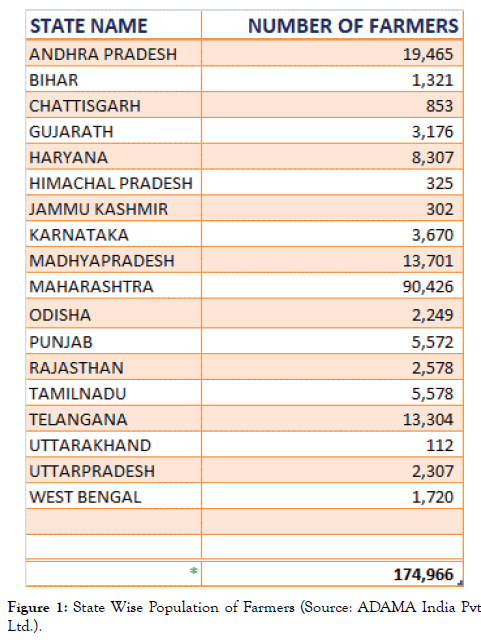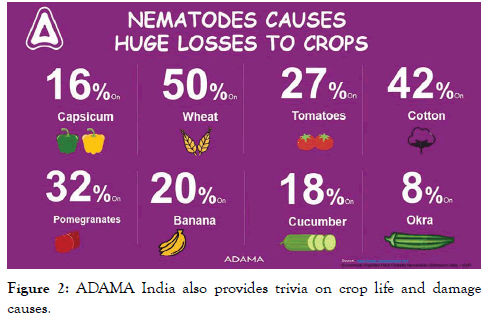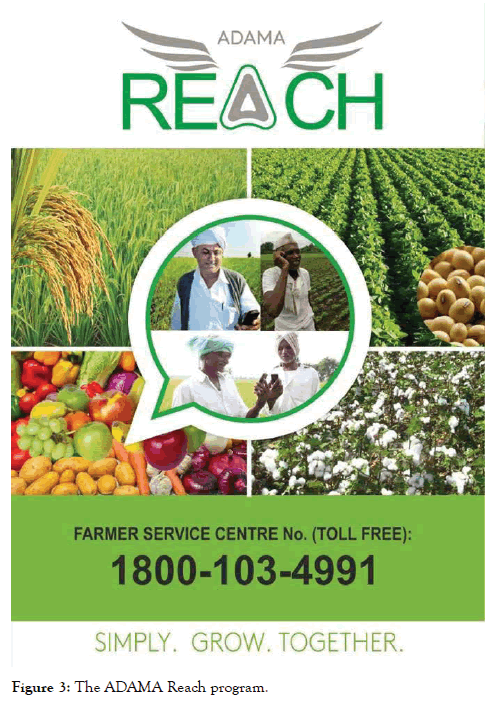Indexed In
- Genamics JournalSeek
- RefSeek
- Hamdard University
- EBSCO A-Z
- OCLC- WorldCat
- Publons
- Euro Pub
- Google Scholar
Useful Links
Share This Page
Journal Flyer

Open Access Journals
- Agri and Aquaculture
- Biochemistry
- Bioinformatics & Systems Biology
- Business & Management
- Chemistry
- Clinical Sciences
- Engineering
- Food & Nutrition
- General Science
- Genetics & Molecular Biology
- Immunology & Microbiology
- Medical Sciences
- Neuroscience & Psychology
- Nursing & Health Care
- Pharmaceutical Sciences
Case Report - (2019) Volume 8, Issue 2
Digital Farming: Integrating Farming with Information Technologies to Attain the Best Yields, Cases from Andhra Pradesh, Telangana & Karnataka
Srujan Kashyap Dendukuri*Received: 24-Aug-2019 Published: 06-Nov-2019
Abstract
Animals, birds and insects, including ants, the tiniest creatures on the earth adopt food security techniques in order to preserve food for the future needs. They are aware that they cannot venture out to hunt for food on a rainy season. They are strategic in choosing their path during rainy and winter seasons when the temperatures and weather conditions would be at their extreme levels. While ants work hard to save food in their hillocks in the tropical rain forests during summer, polar bears hibernate by lowering their body metabolism and stay away from food consumption. Amidst global warming and extreme climate scenario, it is time for the human to act. As intelligent beings on the earth with an ability to communicate, research, share and disseminate knowledge using information technologies, farmers can take the competitive advantages of the information technologies (ICTs) to increase their crop yields. Microsoft India in collaboration with the International Crops Research Institute for the Semi-Arid Tropics (ICRISAT) has been leveraging the AI, Machine Learning and Cloud Technologies to unleash the information on changes in temperature, precipitation and possibilities of pest attacks in advance and could communicate the same to the farmers in the South Indian states of Andhra Pradesh and Karnataka through SMS alerts. Farmers are receiving information digitally on how and when should they sow the seeds and what type of pest control measures should they adapt to mitigate them. Right from predicting the market prices and the ground water density, AI technologies can go a long way in achieving the Digital Green Revolution. The researcher is keen in presenting the experiences of the farmers of AP, Telangana and Karnataka by presenting cases of Microsoft & ICRISAT and ADAMA India Ltd.
Keywords
Farming; Yields; Digital farming; Farmers
Introduction
India is one of the fastest growing economies in the world with the second largest population. The Agricultural sector is the largest employer in India, as India had been a predominantly agricultural economy, even prior to its colonization by the British. Today 54.6% of the total workforce s in India is employed in the Agricultural sector. However, Agriculture’s share in GDP is declining (17% as of 2013-14). There are many factors attributing to this contrast. While the rapid economic growth in the manufacturing and service sectors are taking advantage of the Technological Advancements and research innovations the performance of agricultural sector is dependent on factors beyond human control such as Monsoon. To make things complicated, the Monsoon cycle has become unpredictable due to the onset of Global Warming, and Climate Change. According to the estimations of the United Nations Food and Agriculture Organization.
The global population would exceed 2 billion by 2050 and only 4% of the additional land would be added for the cultivation due to increasing urbanization globally. In order to feed the increasing global population, the nations must embrace the emerging technologies like Machine learning or AI to meet the growing demand for the food production [1]. Therefore, I will be focusing in this paper on how Information Technology and Data Sciences can be used to catalyze the growth of agriculture in India in general and South Indian states in particular. Machine Learning (ML), Artificial Intelligence (AI) can be used as predictive tools for forecasting climate conditions, possible pest attacks, diagnosis of pest attacks, and for providing preventive measures. ML can also be used to predict market trends and aid in pricing strategies. Cloud technology on the other hand can be helpful in setting up a model for the Environmental Communication. Using ICTs, the Government and the agencies working closely with formers can setup help-lines to address farmer’s concerns, maintain harvester’s records and the performance of Individual farmers. According to Internet society.org, Artificial intelligence (AI) is a rapidly advancing technology, made possible by the Internet would have significant impacts on our everyday lives. AI traditionally refers to an artificial creation of human-like intelligence that can learn, reason, and plan, perceive, or process natural languages. These traits allow AI to bring immense socioeconomic opportunities, while also posing ethical and socio-economic challenges [2]. This paper explains how Digital Green Revolution can be achieved by means of the latest technologies. Machine learning is one of the disciplines of the artificial intelligence (AI) that is geared toward the technological development of human knowledge. Machine learning allows computers to handle new situations via analysis, self-training, observation and experience [3]. Machine Learning (ML) with big data technologies and high-performance computing could create new opportunities with its data intensive approach to create multi-disciplinary agri-technologies to boost the agricultural yields. It assists in crop management by predicting the crop yield, onset of diseases, weeds, quality of the crop, and species It is useful in the livestock management suggesting the best animal welfare practices and livestock production. It is immensely helpful in the water management and soil management [4]. The government of India under the stewardship of the ‘Niti Ayog’, the highest policy making body in India has adopted a three-pronged approach such as undertaking exploratory proof-of-concept AI projects in various areas, drafting a national strategy for building a vibrant AI ecosystem in India and collaborating with various experts and stakeholders. Since the beginning of this financial year, NITI Aayog has partnered with several leading AI technology players to implement AI projects in critical areas such as agriculture and health [5].
Before proceeding further with the study, it is essential to introduce the key technology players that are instrumental in taking the information technologies close to farmers to set the best agricultural practices.
Microsoft India Private Limited is a subsidiary of American software company, Microsoft Corporation. Established in the year 1990, Microsoft India is one of the fastest developing subsidiaries of Micro Soft Corporation. Head quartered at Hyderabad, the capital of Telangana. With more than 6500 employees, Micro Soft India believes that technology innovation is critical to sustainable economic growth and social development. It works on things that make a real difference in the lives of billions of people (Figure 1) [6].

Figure 1. State Wise Population of Farmers (Source: ADAMA India Pvt Ltd.).
International Crops Research Institute for the Semi-Arid Tropics (ICRISAT) is an international non-profit organization that undertakes scientific research for development. It believes in universal right to the food security and better livelihood. It aims at reducing poverty, hunger, malnutrition and environmental degradation in dry tropical land [7].
ADAMA India Ltd began its journey in India as Makhteshim Agan Ltd in the year 2009 with its headquarters at Israel. It turned as ADAMA India in the year 2014 with changes in the management. Currently, ADAMA India is producing herbicides, fungicides and pesticides to mitigate pests to improve crop yields in India. It is currently working with 6 lakh Indian farmers (Figures 2 and 3) [8].

Figure 2. ADAMA India also provides trivia on crop life and damage causes.

Figure 3. The ADAMA Reach program.
Methodology and Data Collection
The researcher has chosen case study as research technique in exploring the way the ICTS can be used in assisting farmers to follow the best agricultural practices like marketing and distribution techniques. According to Press academia, case study can be defined as a research strategy and an empirical inquiry that investigates a phenomenon within its real-life context. Case studies are based on an in-depth investigation of a single individual, group or event to explore the causes of underlying principles. A case study is a descriptive and exploratory analysis of a person, group or event. A case study research can be single or multiple case studies, includes quantitative evidence, relies on multiple sources of evidence and benefits from the prior development of theoretical propositions. Case studies are analysis of persons, groups, events, decisions, periods, policies, institutions or other systems that are studied holistically by one or more methods. While the data on Microsoft & ICRISAT was gathered with the help of secondary data available. Facts on ADAMA India was collected from the call center that is directly involved in communicating with the farmers across India.
Case Study: Microsoft India and Icrisat
Employing Artificial Intelligence in Agriculture is not a novel concept. Microsoft in collaboration with International Crop Research Institute for the Semi-Arid Tropics (ICRISAT) has developed an AI powered mobile app which sends sowing advisories to farmers, providing the best date to sow the seeds. The most notable aspect of this application is, the farmers need not install any sensors in the field, and all they need is a phone capable of receiving text messages. A pilot program was conducted involving 174 farmers from Devanakonda of Kurnool District, Andhra Pradesh, India, who sought advice provided by the AI powered app. The results showed that all of the farmers had a 30% increase in yield on an average. The application predicted the optimal sowing dates based on the historic climate data of Devanakonda from 1986-2015 along with Moisture Adequacy Index (MAI). MAI is a measure for assessing the degree of adequacy of rainfall and soil moisture to meet the potential water requirement of crops. Even with historic climate data an accurate measure cannot be obtained, because of the Climate change. This is where State Development Planning Societies and Indian Meteorological Department come into the picture. Such bodies can help in providing real time data for further accurate estimation. In technical terms, this is called regression, where a dependent output variable is determined by multiple input variables by means of mathematical and statistical formulae. Simultaneously, a village advisory board was setup which was personalized for each village. These advisory boards provided information regarding soil health, probability of pest attack and weather forecasting for the week. This program was extended across 3000 farmers of Karnataka and Andhra Pradesh.
Further, an application was developed in collaboration with United Phosphorous (UPL), India’s largest agrochemical producer, which would predict pest attacks. This application considers the geographic location, season and weather forecasts, and crop stage to provide data. The data received was categorical such as High, Medium and Low.
Microsoft developed a multivariate agricultural commodity price forecasting model to predict the optimal prices of commodities based on the current market trend. The model used remote sensing data from satellite images for prediction. Many input variables were considered for value-based pricing. The model is known to be scalable, time efficient and can be generalized for many regions.
Case Study: Adama Agricultural Solutions
Established in the year 2012, Makhteshim Agan India Pvt. Ltd. Was an Israeli company that started its operation in Hyderabad, India as its headquarters and has spread its presence throughout India. The company’s strength lies in its field staff, comprised of it marketing and sales force. The company could identify volunteers from the agricultural colleges and universities across the states of India and has established a strong network that could communicate, answer, or clear the queries the farmers rise from time to time. MA India has also setup a call center and employed staff to interact directly with farmers. The company gained immense expertise in addressing the challenges the farmers face. Each member in its network take at least 15 calls a day and a field force of 1000 attend at least 15,000 calls a day. The moment the call center staff receive a call from a particular state, say for example, Punjab, it will be directed to the marketing/sales force of that particular state so that they could attend the issue. MA India became ADAMA India ltd with a change in the management in the year 2014 [7].
ADAMA India has reached 1, 74, 966 farmers in the year 2017 and 36439 in AP, Telangana and Karnataka, it could interact with farmers through various media of communication. ADAMA India continued the farmer’s extension service policies and has deployed SMS, Voice Messages, services so that the farmers can voice or text their concerns or receive solutions. The field staff should visit the farmers of their allocated area on a regular basis. Right from the date when the farmer sown the seeds, the field staff continue their services until they harvest the yield. They take photographs of any specific incident like pest attack and can send the pictures instantly to the research center that operates at Hyderabad with scientists working in their R&D center. The executives/employees that work at the call centers take the issue to the R&D department and discuss with them to offer instant solutions to them.
ADAMA India has also embraced the modern means of communication channels, particularly the new interactive voice based text using smart phones. The farmer can get instantaneous solutions to a particular pest within seconds. All he has to do is to snatch the photograph of the pest that affected the crop and click on the send button to get the same in Pictoral form or Video call or voice based or combination of Multimedia- text remedy within no time. The company has provided its field staff with a tablet and they can extract a picture of the affected plant and can seek answers to support the farmers. The researcher that designed the ‘Virtual Servicing Center for the Farming community is keen in demonstrating the way the virtual media networks facilitating social change and sustainable development through relevant and meaningful communication.
Discussion and Conclusion
It is evident from both the cases presented above. Both the Microsoft India & ICRISAT and the ADAMA India have been using modern means of communication technologies to sense and detect.
And offer solutions. While the Microsoft India is using the most advanced forms of technologies like Machine learning and AI, ADAMA India is using interactive voice based technologies and social media platforms. The researcher therefore concludes that the modern communication and information technologies can be leverage to encourage the best farm practices. The digital green revolution is a reality today, though not very extensive and widespread a practice in the entire India. However, the day is not very far away for The India to embrace the digital green policies.
Limitations of the Study
While ADAMA India has been working with farmers to offer the best possible solutions for the past 3 years and could reach farming community considerably, the Microsoft India’s experiment is still at the introductory level and the researcher could not collect extensive data on it.
Recommendations
The researcher recommends making a follow-up study on Microsoft & ICRISAT in future, at least after one year so that it is possible to assess its impact of ICTs in transforming the farm practices.
REFERENCES
- Dharmaraj V, Vijayanad C. Artificial Intelligence (AI) in Agriculture. IJCMAS. 2018; 7(12):2122-2128.
- https://www.internetsociety.org/resources/doc/2017/artificial-intelligence-and-machine-learning-policy-paper/?gclid=CjwKCAjw0oveBRAmEiwAzf6_rCN8BtsvRTkoGWCRemdIb-r2ZCTe3vh50uN-q7j7F_NHXLdVYinKjhoCE9UQAvD_BwE
- https://www.techopedia.com/definition/8181/machine-learning
- Liakos KG, Busato P, Moshou D, Pearson S, Bochtis D. Machine Learning in Agriculture: A Review. Sensors (Basel). 2018; 18(8):E2674.
- https://niti.gov.in/writereaddata/files/document_publication/NationalStrategy-for-AI-Discussion-Paper.pdf
- https://www.microsoft.com/en-in/about/about-microsoft/microsoft-in-india.aspx
- https://www.icrisat.org/overview/
- https://www.adama.com/india/en/crop-protection
Citation: Dendukuri SK (2019) Digital Farming: Integrating Farming with Information Technologies to Attain the Best Yields, Cases from Andhra Pradesh, Telangana & Karnataka. Int J Swarm Evol Comput 8:177. doi: 10.35248/2090-4908.19.8.177
Copyright: © 2019 Dendukuri SK. This is an open-access article distributed under the terms of the Creative Commons Attribution License, which permits unrestricted use, distribution, and reproduction in any medium, provided the original author and source are credited
Sources of funding : No funding


